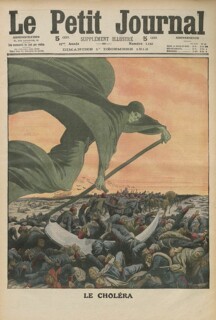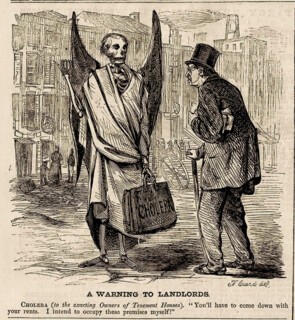Visualising Viruses
Michael Rossi
When the expressionist painter Alfred Kubin imagined epidemic disease in 1905, he saw a giant slug with a human skull for a head, slithering across the landscape and leaving pestilence in its wake. On the cover of Le Petit Journal of 1 December 1912, cholera was shown as death personified, black-hooded and skeletal, scything soldiers and civilians to the ground as they fled its advance. In 1562, Bruegel had painted the plague as an army of skeletons marauding through Europe, killing kings, peasants, priests and sinners with equal disregard. Depictions of the virus that causes Covid-19, however, have not had to resort to symbolism. We know what the pathogen looks like: a ball studded with rococo spikes, the ‘crown’ that gives the coronavirus its name. At first glance, this shift looks like progress.
To be able to see something as small as a virus is a triumph of modern science. For early physicians, the term ‘virus’ meant a speculative particle that transmitted disease – and it was an explanation used mainly by peasants, compared with the more philosophically complex theories of learned physicians. After the development of the germ theory of disease in the 1860s, viruses – unlike larger, more easily seen bacteria – were hypothesised as liquids. They clearly caused sickness, but were invisible under the microscope and slipped through even the finest screens. When, in 1938, a member of the smallpox family (this one infectious to mice) was first imaged by electron microscopy, and the pictures of shadowy blobs published in the Wiener Klinische Wochenschrift, viruses finally took on not only size and shape, but a sort of stable reality.
Yet contemporary renderings of Sars-CoV-2 are not simply snapshots of reality. They are in their way as stylised as ink drawings of cadaverous ghouls, or oil paintings of death mocking unsuspecting burghers. They are the product of countless choices made by illustrators and designers over what to depict, what colours to use, how to frame their subject – over the ‘branding’ of the pathogen’s image, as one designer put it. And while the impeccably rendered pictures may ‘grab the public’s attention’ and raise awareness of hygienic practices, they miss an opportunity to address the ways in which science, medicine and governance coalesce around such political matters as fear, injustice and the unequal distribution of resources.
Compare the contemporary figure of Covid-19 as a geometrical shape floating in abstract space with an image of cholera in New York in 1866: a cartoon in Harper’s depicted the disease as a winged skeleton carrying a suitcase, telling a stingy plutocrat to bring his rents down because it’s going to move into his tenements – a reminder that disease is not simply a technical problem, but a moral and political one, too. In contrast, knowing what the virus ‘looks like’ – if something that’s smaller than the wavelength of light can be said to ‘look’ like anything – is an ambiguous experience. What – other than the (possibly erroneous) sense that somehow, somewhere, a coalition of scientists, administrators and elected officials are working on the problem – is such an image meant to signify?
Recourse to a visual language of technical proficiency – featuring no people, no social concerns, no sufferers – is itself a moral statement. Or rather, it is a denial of moral responsibility which, in fact, acknowledges that responsibility even as it runs from it. The message of the notionally ‘objective’ imaging of Covid-19 is that we ought not think too hard or too widely about disease, beyond the immediate and personal response of washing our hands.
The beautiful, chilling illustrations leave out any sense that the virus and the social response to it are connected. Just as there can be no picture of the virus without human observers, there can be no observation of disease without human considerations. Perhaps future historians will decide that our abundant images of the isolated virus – cold, singular, detached from a sense of social reality – are a fitting emblem for our contemporary crisis. But we owe it to ourselves to try to see it differently.



Comments